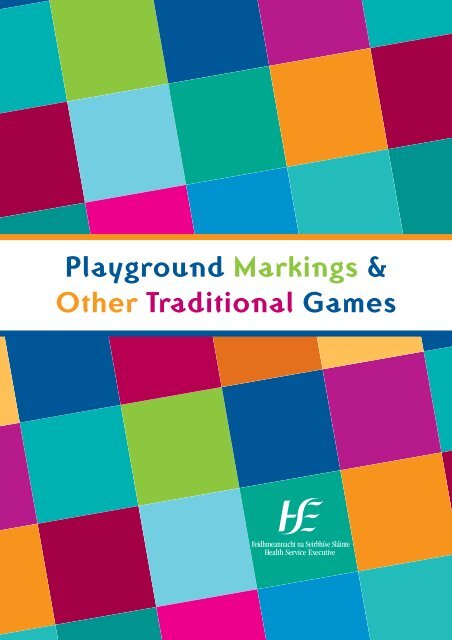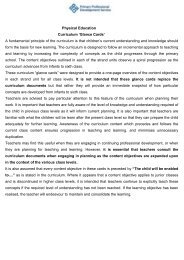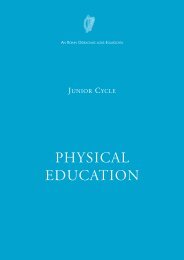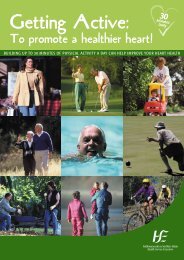Playground Markings & Other Traditional Games - Get Ireland Active
Playground Markings & Other Traditional Games - Get Ireland Active
Playground Markings & Other Traditional Games - Get Ireland Active
You also want an ePaper? Increase the reach of your titles
YUMPU automatically turns print PDFs into web optimized ePapers that Google loves.
<strong>Playground</strong> <strong>Markings</strong> &<br />
<strong>Other</strong> <strong>Traditional</strong> <strong>Games</strong>
<strong>Other</strong> resources available from the Health Promotion Department, HSE<br />
South to support and encourage physical activity with children include:<br />
1) Lets <strong>Get</strong> Physical Pocket Play Pack<br />
2) <strong>Get</strong> Kids on the Go – A5 booklet and poster<br />
3) Little Steps Go A Long Way – DL booklet<br />
4) Bizzy Breaks Resource Pack (includes CD and poster) – Activities for<br />
the classroom designed to get pupils moving on the spot<br />
5) Action for Life – A resource for primary school teachers<br />
6) Action for Everybody – A resource for primary school teachers<br />
The Health Promotion Department, HSE South would like to acknowledge<br />
the contribution of the following;<br />
The Health Promotion Department, HSE North East<br />
The Waterford Sports Partnership<br />
The Languages, Tourism and Sports Studies Department at the<br />
Waterford Institute of Technology<br />
This original resource was prepared in 2004 by Dr. Paula Carroll, PhD;<br />
Research Officer at Waterford Institute of Technology for the Health<br />
Promotion Department of the South Eastern Health Board. This revised<br />
edition was prepared by Catherine O’Loughlin, Regional Health<br />
Promotion Officer for the Health Promotion Department, Health Service<br />
Executive, South.
Contents<br />
Page No<br />
Introduction 1<br />
<strong>Games</strong><br />
<strong>Playground</strong> <strong>Markings</strong><br />
(i) The Compass 2<br />
(a) Compass Tig 2<br />
(b) Compass Ball 2<br />
(c) Compass Toe the Line 3<br />
(d) Target Practice 3<br />
(ii) Activity Circuit 4<br />
(a) Stepping Stones 4<br />
(b) Jump/Jumping Lines 4<br />
(c) Balance Beam 4<br />
(d) Squiggly Line/Running Line 4<br />
(e) Hop/Frog Prints 5<br />
(f) Skip/Foot Prints 5<br />
(g) Slalom 5<br />
(iii) Hopscotch 6<br />
(a) Hopscotch 6<br />
(b) Claiming Hopscotch 7<br />
(c) Search-A-Round 7<br />
(d) Relay Hopscotch 7<br />
(iv) The Maze 8<br />
(a) Crazy Maze 8<br />
(b) Wolf and Rabbits 9<br />
(c) Collect the Treasure 9<br />
(v) The Clock 10<br />
(a) Cat and Mouse 10<br />
(b) Target Game 11<br />
<strong>Other</strong> <strong>Playground</strong> <strong>Games</strong><br />
(i) <strong>Traditional</strong> <strong>Games</strong> 12<br />
(a) Prison Wall 12<br />
(b) Farmer Farmer may we cross your golden river? 12<br />
(c) 40/40 12<br />
(d) The Hunted 12<br />
(e) Human Pretzel 13<br />
(f) Snatch the Bacon 13<br />
(g) Team Game 13
(ii) Skipping <strong>Games</strong> 14<br />
(a) Under the Moon 14<br />
(b) Over the Stars 14<br />
(c) Follow the Leader 14<br />
(d) Twisting and Turning 14<br />
(e) Co-operative Jumping 15<br />
(f) Vote for DeValera 15<br />
(g) Postman 15<br />
(h) Girl Guide 16<br />
(i) Teddy Bear 16<br />
Laying Your Own <strong>Playground</strong> <strong>Markings</strong> 17<br />
Health Promotion Department Contacts 21<br />
Notes 22<br />
You Tell Me, I Forget<br />
You Teach Me, I Learn<br />
You Involve Me, I Remember<br />
Benjamin Franklin<br />
Ex-President of the United States of America
Introduction<br />
<strong>Traditional</strong>ly, playground games have always been an integral part of childhood leisure time,<br />
which is not surprising given the fact that children can spend up to 21% of their time at school<br />
in the playground. As well as offering children an opportunity to be physically active during<br />
the day, games played during breaktime also provide children with a vehicle for social<br />
interaction and a platform for creativity. Current physical activity guidelines recommend that<br />
young people should participate in physical activity that is developmentally appropriate,<br />
enjoyable, and of at least moderate intensity for one hour per day. Young people who currently<br />
do little activity should participate in physical activity of at least moderate intensity for at<br />
least half an hour per day. At least twice a week, some of these activities should help to<br />
enhance and maintain muscular strength and flexibility, and bone health 1 . Research<br />
conducted in the UK, however, has reported an increase in the proportion of children who do<br />
not participate in any physical activity during school time from 15% (1994) – 18% (2002) 2 .<br />
There is much anecdotal evidence to suggest that this statistic is also representative of trends<br />
in Irish Society. The Health Behaviour in School-Aged Children (HBSC) survey reported that<br />
overall 11% of children surveryed exercised less than weekly (7% of boys and 14% of girls) 3 .<br />
Data from the Central Statistics Office indicate a clear decline in the percentage of young<br />
people who walk or cycle to school (actively commute) in <strong>Ireland</strong> over the last two decades. The<br />
proportion of 5-12 year olds who walk to school decreased from 47% in 1981 to 39% in 1991 to<br />
26% in 2002 to only 24% by 2006 4 . The reduction in activity levels may also be reflected in the<br />
recent increase in childhood obesity levels in this county. One in every 5-12 year olds in <strong>Ireland</strong><br />
are overweight or obese 5 . In addition to potentially tackling rising obesity levels, playground<br />
activity has also been shown to improve attention and reduce anti-social behaviour and<br />
bullying levels among children 6 . The purpose of this resource, therefore, is to use the<br />
<strong>Playground</strong> <strong>Markings</strong> and <strong>Games</strong> to increase the level of school based physical activity and<br />
play as well as increasing the number of children who are active during school time.<br />
The nature of games outlined in this resource are such that even the least active of children<br />
can get some enjoyment from playing these games. All games are task orientated and<br />
research has shown that such an environment increases enjoyment, adherence and<br />
motivation in pupil involvement and learning in physical education 7 . <strong>Games</strong> are also aimed<br />
at group and/or individual participation to suit all children.<br />
While the <strong>Playground</strong> <strong>Markings</strong> and <strong>Games</strong> resource does have considerable potential, the<br />
involvement of the school is paramount to ensure that potential is maximised.<br />
Familiarisation of the teachers and children with the games is essential for success in this<br />
venture.<br />
We hope that this resource will facilitate you, the teacher, in getting the children in your<br />
care more active!<br />
References:<br />
1. Biddle S, Cavill N, Sallis JF. Policy framework for young people and health enhancing physical activity. In: Biddle<br />
S, Cavill N, Sallis JF, editors. Young and active? Young People and health-enchancing physical activity – evidence<br />
and implications. London: Health Education Authority, 1998: 3-16<br />
2. Data collected by Sport England and reported by Chaudhary, (2003) Fewer children join in sport at school. The<br />
Guardian Newspaper, UK.<br />
3. HBSC Study (2006). Health Promotion Research Centre, National University of <strong>Ireland</strong>, Galway; Department of<br />
Health & Children, Government of <strong>Ireland</strong>, Dublin.<br />
4. Central Statistics Office, Government of <strong>Ireland</strong>, Census of Population, Volume 12, Travel to work, school and<br />
college. www.cso.ie/census/census2006. Reference type: Electronic citation.<br />
5. The National Children’s Food Survey (2005) IUNA. www.iuna.net<br />
6. Kelso, P (2002) New style playground markings could help tackle obesity. The Guardian Newspaper, UK.<br />
7. Ntoumanis, N & Biddle S, (1999) A review of motivational climate in physical activity. Journal of Sport Sciences, 17,<br />
643-665.<br />
1
The Compass<br />
How to Put Down This Marking<br />
➢ Centre circle 3ft diameter.<br />
➢ Chalk in 2 further circles one of<br />
2m diameter and one of 3m<br />
diameter.<br />
➢ Divide into eight equal sections<br />
through center points. Extend<br />
lines through all circles and<br />
align N and S to compass<br />
points.<br />
➢ Chalk in N, S, E, W triangles to<br />
join on edge of inner circle with<br />
apex on outer circle line.<br />
Repeat for other compass<br />
points extending to 2m line.<br />
(a) Compass Tig (Players 6+, No Equipment Needed)<br />
Principle<br />
One child is appointed the Navigator. The Navigator stands in the center of the<br />
compass and calls out different compass points. The children must quickly head<br />
for that point on the compass, without being caught by the Navigator.<br />
Alternatively, the Navigator can call out two compass points and the children<br />
standing on those points must swap positions without being caught by the<br />
Navigator.<br />
Rules<br />
➢ The Navigator may only move to chase the other players once a compass<br />
point has been shouted.<br />
➢ When a player is caught they become the new Navigator and the game<br />
continues.<br />
(b) Compass Ball (8 ideally, Soft Ball/Beanbag Needed)<br />
Principle<br />
Players stand one on each of the inner (NE, NW, SW, SE) and outer (N,S,E,W)<br />
compass points. A soft ball or beanbag is given to one of the players standing on<br />
an outer point. The players on the inner points should move in a clockwise<br />
direction. The ball or the beanbag is thrown to the inner points caught by the<br />
nearest player and passed out to the next of the outer players. To make the game<br />
more demanding;<br />
➢ Introduce a second ball or beanbag and this can increase to a total of 6<br />
beanbags.<br />
2
➢ Change the direction of the inner circle.<br />
➢ Rotate the children at the outer points aswell.<br />
Rules<br />
➢ Should the ball or beanbag drop all players should change position and the<br />
game should start again.<br />
(c) Compass Toe the Line (6 Players)<br />
Principle<br />
Divide children into equal groups (2x3 or 3x2) and assign them a compass point<br />
that is their base. Assign a leader. Children should all move around the<br />
compass, changing direction and altering pace. The group leader calls toe the<br />
line and the children should quickly form into a line, standing one behind the<br />
other, back at their own base. To alter the game, introduce conditions such as toe<br />
the line height, small to tall and the children should form a line tallest to<br />
smallest at their base. Alternative conditions could be shoe size, age, birthday.<br />
Keep children moving in between the toe the line instructions.<br />
Rules<br />
➢ The team which toes the line quickest according to the conditions can<br />
appoint a leader for the next instruction.<br />
(d) Target Practice (any number of children, chalk and 4 beanbags)<br />
Principle<br />
Divide the children into four groups and get them to stand at the nagivational<br />
points N, S, E, W. <strong>Get</strong> them to move 2m back from the navigational point and<br />
draw a line with chalk which they cannot pass. Award points 12, 20, 30 etc. to the<br />
different navigational points i.e. N, S, E, W 10 points, NE, SE, NW, SW, 20 points<br />
and also draw a bullseye in the centre of the compass and also award it points i.e.<br />
30 points. Each child on each team gets three throws of the beanbag and the<br />
team has to add up their points to determine the winner.<br />
Rules<br />
➢ The beanbag must land on the navigational point.<br />
3
Activity Circuit<br />
(1+ Players, Ball, Hoops and Cones Needed)<br />
How to Put Down This<br />
Marking<br />
➢ The circuit can be any<br />
size, as this will be<br />
determined by the space<br />
available.<br />
➢ Use a variety of shapes<br />
and lines.<br />
➢ You are not restricted to<br />
the variations of activities<br />
shown here.<br />
(a) Stepping Stones<br />
The children should move from one step to the next. Try walking on tip-toes or<br />
jumping with both feet.<br />
(b) Jump/Jumping Lines<br />
When the children reach the jumping lines they should try to jump as far as they<br />
can from the baseline. Try to encourage the children to improve their distance<br />
each time they take part on the activity circuit.<br />
(c) Balance Beam<br />
The children walk along the balance beam with one foot in front of the other.<br />
Encourage them to hop when they can walk no problem and even try to get them<br />
to walk backwards.<br />
(d) Squiggly Line/Running Line<br />
Encourage the children to run along the line as quickly as they can. The children<br />
may run with arms outstretched, for example like a plane. Pretend that the line<br />
is a tight rope and practice balancing skills.<br />
4
(e) Hop/Frog Prints<br />
The children run with both feet together along all the prints. Try hopping along<br />
the frog prints on one foot and then the other. If the circuit has different animal<br />
prints, encourage the children to keep their feet on the prints and move like<br />
animals. Children could also be invited to make the sounds of animals.<br />
(f) Slalom<br />
When the children reach the slalom course they should jump alternatively from<br />
side to side of the middle line. Persuade the children to pretend that they are<br />
skiing, with both feet together and knees bent.<br />
(g) Skip/Foot Prints<br />
The children skip along the footprints pretending that they have a skipping rope<br />
circling their arms as they skip.<br />
To make this activity circuit more challenging;<br />
➢ On the stepping stones, get the children to move from stone to stone anyway<br />
the want i.e. hop, jump & twist etc. but they cannot use the same movement<br />
twice.<br />
➢ On the jump section try getting the children to do two legged jumps getting<br />
them to use their arms. Alternatively get them to turn sideways and jump<br />
between the lines bringing their legs up.<br />
➢ On the balance beam encourage them to walk backwards or even get them to<br />
hop along the line.<br />
➢ At the hop section, encourage the children to leap frog or walk on their<br />
hands and feet.<br />
As a variation, try bouncing a ball or even place obstacles along the course - for<br />
example beanbags – which children have to avoid by jumping over them or<br />
running around them. This should be done in a follow the leader fashion.<br />
5
Hopscotch<br />
How to Put Down This Marking<br />
➢ Squares; 30cm x 30cm.<br />
➢ Center Square 60cm x 60cm divided into four triangles.<br />
➢ Number stencils 15cm x 15cm.<br />
➢ Starting from centre square mark squares outwards on three sides Paint<br />
edges in different colours.<br />
Individual games may be played on all three hopscotch markings<br />
at the same time.<br />
(a) Hopscotch (1+ players, beanbag)<br />
Principle<br />
The first player throws the beanbag into square no. 1. The player moves along the<br />
grid using one foot in single squares and two feet in double squares until they<br />
reach the number 10. The player turns around, hopping on one foot, and returns<br />
to the start in the same way, picking up the beanbag when they reach it. The<br />
beanbag is then thrown into no. 2 and the moves repeated until the player has<br />
reached no. 10.<br />
Rules<br />
➢ The beanbag must land within the square. Should it land outside the grid,<br />
on a different square or on the line of the square, it is considered a misthrow<br />
and the player must wait their turn again.<br />
➢ When the player is moving through the grid they must not land on the lines<br />
or outside of the grid. Should they do either of these they must return to the<br />
6
eginning and wait for their next go.<br />
➢ The player cannot put their foot in the square where the beanbag is.<br />
(b) Claiming Hopscotch (1+ players, beanbag)<br />
Principle<br />
As for hopscotch (see (a) above) . In addition to the above, however, once a player<br />
has got to 10 on the grid they can claim a number for their own. No one else can<br />
put their foot in this number when moving through the grid and should they do<br />
so they must go back to the beginning and await their next turn.<br />
(c) Search-A-Round (2+ Players, Three baskets containing different<br />
items eg beanbag, small balls etc)<br />
Principle<br />
Three small teams (~3 members) can play this at any one time, with each team<br />
having a designated hopscotch area. An additional pupil acts as a Caller. The<br />
caller should write a list of numbers from 1-10 and against each number write<br />
down a readily available item. The three baskets could be placed a set distance<br />
away from each hopscotch area from which each item must be collected. On the<br />
Callers instruction the players must retrieve the item from their basket and<br />
place it on the relevant number until all 10 squares are filled. The first team to<br />
collect all 10 items is the winner.<br />
Rules<br />
➢ Each team starts on the number one of their hopscotch area and must begin<br />
collection from that point each time.<br />
➢ Once the item has been placed on the relevant number, a member of the team<br />
may ask the Caller for the next item to be placed on the next number.<br />
➢ Team members must collect item in sequence and the next player cannot<br />
collect an item until their teammate has placed the item on the correct<br />
number.<br />
(d) Relay Hopscotch<br />
Principle<br />
This is similar to the game outlined in section (c) above. In this game however,<br />
each member of the team in turn must run to their basket and retrieve and item<br />
and bring it to the top of the hop scotch grid (by hopping) and place it at the<br />
number 10. Then they must return back down the grid and touch the hand of<br />
their teammate before he/she goes.<br />
Rule<br />
➢ The teammate cannot go until the previous runner has touched their hand.<br />
➢ The runner must not touch the lines of the hopscotch grid. Should they do<br />
so, they must return to no.1 and begin again.<br />
7
The Maze<br />
How to Put Down This<br />
Marking<br />
➢ A variety of lines, the size<br />
of which are determined<br />
by the space available.<br />
➢ Four different colour<br />
shapes indicate each<br />
entry point to the maze.<br />
(a) Crazy Maze (Up to 4 Players, Beanbags Needed)<br />
Principle<br />
Place a number of items randomly in the maze. The players each select an<br />
entrance to the maze which becomes their home base. The aim is for the players<br />
to collect as many items as possible from the maze and return them to their<br />
home base. The player with the most items at wins. Ensure that players change<br />
starting positions at the beginning of each game. The game may be adapted by<br />
adding more items and also by making teams where players must take turns in<br />
retrieving the items on the maze.<br />
Rules<br />
➢ Only one item at a time may be collected from the maze.<br />
➢ Players cannot step over or reach across the lines to collect the items.<br />
(b) Wolf and Rabbits (Up to 5 Players, No Equipment Required)<br />
Principle<br />
One child volunteers to be the Wolf. The Wolf stands in the centre of the maze.<br />
The other players are Rabbits, and they each stand at one of the entrances to the<br />
maze. The aim is for the Rabbits to cross the maze without being caught by the<br />
Wolf. When a Rabbit is caught they become the new Wolf and the game<br />
continues. Alternatively the Wolf can continue until all Rabbits are either<br />
caught or have successfully crossed the maze. The game may also be played<br />
without a Wolf whereby Rabbits must cross the maze as quickly as possible. The<br />
winning player is the first to exit the maze.<br />
8
Rules<br />
➢ Players cannot step over the lines.<br />
➢ Players cannot pass one another out in the maze. Both must choose a<br />
different path.<br />
(c) Collect the Treasure (2+ Players, Treasure eg Beanbag and a<br />
Blindfold are Required)<br />
Principle<br />
Place the Treasure in the centre of the maze. Ask the children to work in pairs.<br />
One member of the duo is blindfolded (or closes their eyes very tightly). The<br />
blindfolded player must journey through the maze by verbal commands given by<br />
their partner. For example two steps forward, turn left. The aim is to guide the<br />
blindfolded player through the maze, to collect the treasure and bring it back to<br />
their partner. Adaptations to this game may include making four teams where<br />
each team has a player entering the maze blindfolded at a different site. The nonblindfolded<br />
partner gives instruction but each takes turn and the first one to<br />
instruct their teammate to the treasure wins. Once the children are happy with<br />
being guided by their partner, it may be possible to place obstacles in the maze.<br />
Rules<br />
➢ The player calling the instructions stands outside the maze and cannot<br />
touch the blindfolded player.<br />
➢ Blindfolded players may not cross over lines and should they do so they<br />
should be guided back to the start of the move.<br />
It should be noted that children at play<br />
are not playing about; their games<br />
should be seen as their most serious<br />
minded activity.<br />
Michel Eyquem de Montaigne<br />
French Author<br />
9
9<br />
10<br />
8<br />
11<br />
7<br />
12<br />
6<br />
The Clock<br />
1<br />
5<br />
How to Put Down This<br />
Marking<br />
➢ Outer circle 3m in<br />
diameter<br />
➢ Chalk in centre point<br />
(1.5m from outer circle)<br />
and draw inner circle<br />
➢ Generate third circle by<br />
putting it midway<br />
between inner and outer<br />
circles<br />
(a) Cat and Mouse (12 people)<br />
Principle<br />
One person stands on each of the numbers of the clock. To begin, the number 12<br />
is the mouse. The cat is always the person 2 people away from the mouse to the<br />
left i.e to begin with the cat is no. 2. The mouse must run in and out of all the<br />
other people until he/she return to the number 12. The cat must chase the mouse<br />
in a similar fashion trying to catch him/her before they return to their starting<br />
position.<br />
Rules<br />
➢ If the mouse gets home without being caught, he/she gets to name the next<br />
mouse.<br />
➢ If the cat catches the mouse before he/she gets home, the cat gets to name<br />
the next mouse.<br />
➢ Both cat and mouse must run in and out of the others players when running.<br />
➢ The other players must keep their hands down by their sides and not try to<br />
obstruct either the cat or mouse.<br />
10<br />
2<br />
4<br />
3
(b) Target Game<br />
Principle<br />
Divide the children into four groups and get them to stand at 2m back from the<br />
clock in four distinct points. Draw a line with chalk which they cannot pass.<br />
Award points 12, 20, 30 etc. to the different circle and also to the bullseye in the<br />
centre. Each child on each team gets three throws of the beanbag and the team<br />
has to add up their points to determine the winner.<br />
Rules<br />
➢ Points are awarded when the beanbag lands within either the first or second<br />
circles or the bullseye.<br />
Play if often talked about as if<br />
it were a relief from serious learning.<br />
But for children, play is serious learning.<br />
Play is really the working of childhood.<br />
Fred Rogers<br />
Host of the longest running public television children’s show in the US<br />
11
<strong>Traditional</strong> <strong>Games</strong><br />
(a) Prison Wall<br />
➢ Two parallel lines are drawn across the middle of the designated area about<br />
one metre apart and this is known as the Prison Wall.<br />
➢ One player stands between the lines and may not go beyond them.<br />
➢ The other players have to run across the lines without being touched.<br />
(alternatively you can get the prison guard to throw beanbags at the other<br />
children providing they are encouraged to throw from the waist down)<br />
➢ If they are touched they must join the prison guards on the wall.<br />
(b) Farmer, farmer, may we cross your Golden River?<br />
➢ One pupil is named as the farmer and stands in the middle of the designated<br />
area of the playground while the others stand about 10 metres away. The<br />
players call out, farmer, farmer, may we cross your golden river?<br />
➢ The farmer replies, choosing a colour, You may not cross my river unless you<br />
are wearing something BLUE.<br />
➢ The players who are visibly wearing this colour (even if it is only part of a<br />
garment) can cross the river in safety.<br />
➢ Those players who are not wearing the colour have to run across the gap<br />
without being caught by the farmer.<br />
➢ If a player is caught, he or she must help the farmer.<br />
➢ The last person to be caught becomes the farmer in the next game.<br />
(c) 40/40<br />
➢ Similar to hide and seek except the seeker has a base to which the players<br />
must return from their hiding places without being seen by the seeker.<br />
➢ The seekers role is to spot the players and touch the base, stating 40/40<br />
I see ….. before that person reaches the base.<br />
➢ Once a person has been caught they must sit out until all players have been<br />
caught.<br />
➢ The first to be caught is the seeker in the next game.<br />
(d) The Hunted<br />
➢ In this game all players seek one person. Everyone hides their eyes and counts<br />
to a particular number while one person goes off to hide, aiming to find an<br />
especially difficult place.<br />
➢ The person who is hiding is able to change hilding place throughout the<br />
duration of the game. Care must be taken not to be seen, as being seen means<br />
being caught.<br />
➢ Whoever catches the player who is hiding can hide in the next game.<br />
12
(e) Human Pretzel (no limit on participants)<br />
➢ Two people close their eyes.<br />
➢ The others hold hands in a circle and twist themselves over and under through<br />
each other without dropping hands.<br />
The two people open their eyes and are challenged to untangle the group.<br />
(f) Snatch the Bacon<br />
➢ Team A lines up side by side opposite team B who line up in the same way.<br />
Teams facing one another should be 20m apart.<br />
➢ A soft object, beanbag, jumper etc is placed in between the two teams.<br />
➢ A captain is selected on each team and these will start the game.<br />
➢ Captain from team A shouts GO and the two captains run towards the middle<br />
and try to retrieve the object and return to their side again.<br />
Whoever returns to their side with and object and without being caught gets to<br />
go again and can choose who they would like to run against the next time.<br />
(g) Team Game (even number of players + 1 caller)<br />
Team A lines up opposite team B sitting on the ground with approximately 1/2 m<br />
between players. Each opposing pair gets a number from 1 to ? depending upon<br />
the number of players. The caller picks a number and the pair with that number<br />
must get up and run right round their team and go back to their sitting position<br />
before their opposing number.<br />
13
Skipping <strong>Games</strong><br />
The following games involve using a 14ft rope that will require two turners. Try<br />
to ensure that turners are replaced frequently. The following games can be used<br />
to enable the pupils to acquire the necessary skills for skipping games. At any<br />
time when a pupil is having difficulty leaving the rope, encourage them to<br />
continue skipping until they can jump out. There is no limit to the number of<br />
participants in these games.<br />
(a) Under the Moon<br />
➢ Turners turn the rope towards the skipper.<br />
➢ Skipper stands close to one of the turners.<br />
➢ As the rope passes in front of the skipper and brushes the floor, rotating up<br />
and away from her or him, the skipper runs under the moon i.e. the rope.<br />
➢ The skipper then continues running around the turners in a figure of eight to<br />
run under the moon again.<br />
➢ Encourage skippers to enter and exit the rope on a diagonal.<br />
(b) Over the Stars<br />
➢ Turners turn the rope away from the skippers.<br />
➢ As the rope clips the floor and starts moving towards the skipper, the skipper<br />
jumps over the stars i.e. the rope.<br />
Once these two skills have been acquired a number of games can be played.<br />
(a) Follow the Leader<br />
➢ Pupils follow one another through the rope taking turns.<br />
(b) Twisting and Turning<br />
Before entering the skipping rope the pupils set themselves challenges such as;<br />
➢ Hopping 10 times on their left foot.<br />
➢ Turning around 180∞ while skipping.<br />
➢ Turning around 180∞ while skipping on one foot.<br />
➢ Touching the ground in-between skipping.<br />
➢ Entering one at a time, they must try not to have two skippers in at the same<br />
time so the first in must leave quickly so as not to be caught by the new<br />
skipper coming in.<br />
➢ Two skippers holding hands for 20 skips.<br />
14
(c) Co-Operative Jumping<br />
➢ Two players turn the rope while the other players line up to jump.<br />
➢ The first player jumps once, runs out and takes the end of the rope from one<br />
of the turners.<br />
➢ The player he/she take it from goes to the end of the line.<br />
➢ Meanwhile the second player has to jump twice, run out and take the rope<br />
from the other player who has been turning it, relieving that player to go to the<br />
end of the line.<br />
➢ The third player jumps three times and runs out and so on….<br />
➢ It a miss occurs, the next player begins over again, jumping once and so on.<br />
(d) Vote for DeValera<br />
➢ One pupil starts by jumping into the turning rope and skips singing the tune<br />
below. At the key time in the tune they invite a new skipper to join them<br />
skipping and then again at the key time in the tune they exit themselves and<br />
the new skipper starts the tune again.<br />
Vote, vote, vote for DeValera,<br />
In comes, ? (name another skipper)<br />
at the door Ay Oy,<br />
? (The new skippers name) is the one<br />
who is having all the fun<br />
And we don’t need ? (the original skippers name)<br />
Anymore Ay Oy.<br />
(e) Postman<br />
➢ One pupil starts by jumping into the turning rope and skips singing the tune<br />
below.<br />
Early in the morning at half past eight,<br />
I heard the postman knocking at the gate,<br />
1,2,3,4,5,6,7,8,9,10,<br />
Postman, Postman drop your letter,<br />
Lady, Lady pick it up and out you go.<br />
15
(f) Girl Guide<br />
➢ One pupil starts by jumping into the turning rope and skips singing the tune<br />
below. The pupil who is skipping must do the actions while skipping.<br />
I am a girl guide dressed in blue,<br />
These are the actions I must do,<br />
Salute to the Captain, Bow to the Queen,<br />
Twist right around and count to fifteen,<br />
1,2,3,4,5,6,7,8,9,10,11,12,13,14,15.<br />
(g) Teddy Bear Teddy Bear<br />
➢ One pupil starts by jumping into the turning rope and skips singing the tune<br />
below. The pupil who is skipping must do the actions while skipping.<br />
Teddy Bear, Teddy Bear, Turn Around<br />
Teddy Bear, Teddy Bear, Touch the Ground<br />
Teddy Bear, Teddy Bear, Climb Upstairs<br />
Teddy Bear, Teddy Bear, Say your Prayers<br />
Teddy Bear, Teddy Bear, Turn out the Light<br />
Teddy Bear, Teddy Bear, Say Goodnight<br />
16
Laying Your Own <strong>Playground</strong> <strong>Markings</strong><br />
Step by Step Guide<br />
<strong>Get</strong> Commitment.<br />
Arrange a meeting of the board of management or parents council to get<br />
commitment for the project.<br />
Decide a Budget<br />
Decide on a budget. It is cheapest for playground markings to be painted down<br />
by parents, staff or members of the local community.<br />
Observe the children at play<br />
Observe what games are already being played in the yard, ask the children for<br />
ideas for games. You are not limited to the ideas presented in books. Visit<br />
other schools with markings and ask which games work best.<br />
Measure and design your yard<br />
Measure your yard and using the ideas from the children and other sources<br />
plan your yard.<br />
Test out the games<br />
Do a ‘dry a run’, by chalking down the planned markings. This will give you an<br />
idea of which games are most popular and where each game should be<br />
positioned.<br />
Finalise Design<br />
Decide on the final design for your playground and using the playground<br />
markings stencils available from your local health promotion office and the<br />
tips below create an exciting and colourful playground.<br />
Workshop<br />
Contact the Health Promotion Department for a playground markings<br />
workshop to be delivered to the pupils and teachers. Contact details are on the<br />
back page of this booklet.<br />
What is in the Pack?<br />
Stencils:<br />
➢ Letters A – Z in uppercase<br />
➢ Letters a – z in lowercase<br />
➢ Cards suits<br />
➢ Numbers 0 – 9<br />
➢ Footprints<br />
17
These basic shapes will help you paint down the markings contained in this<br />
booklet as well as allowing you and the children to invent and design games<br />
yourself.<br />
Instruction Cards:<br />
These cards give step by step instructions on how to use the stencils to paint<br />
down certain markings for example:<br />
Maze Activity Circle<br />
Twister Hopscotch<br />
Clock Compass<br />
Please see the poster ‘<strong>Get</strong> a Life, <strong>Get</strong> <strong>Active</strong>-<strong>Playground</strong> <strong>Markings</strong> and <strong>Other</strong><br />
<strong>Playground</strong> <strong>Games</strong>’ for pictures of the above markings. These stencils are<br />
designed to be used to chalk down the markings, after which you paint in the<br />
chalk outlines. Using the stencils with paint may cause the paint to ‘bleed’<br />
outside the boundary of the stencil, ruining the shape of the marking. Please<br />
note you may need to draw some of the markings in free hand for example the<br />
squiggly lines in the activity circle marking and the outline/boxes for the<br />
hopscotch marking.<br />
Who can use the stencils?<br />
➢ Teachers<br />
➢ <strong>Other</strong> school staff<br />
➢ Caretakers<br />
➢ Secondary school students<br />
Using the Stencils<br />
What type of paint should I use?<br />
When buying paint ask about area of coverage per tin. Divide this by half to<br />
allow for tarmac absorption. You can also use spray cans (Plastikote Industrial<br />
upside down marking paint is also ideal. Each can cover 4m 2 approximately).<br />
These paints can be purchased from any good hardware shop or paint supplier.<br />
You can generally get any colour mixed from a colour card.<br />
Always make sure that the paint is exterior quality.<br />
18
Avoid pastel colours and go for primary bright colours. If using tinned paint do<br />
not try to mix secondary colours yourself from the tins. Industrial paints do<br />
not mix like artists colours and you will end up with a brown mess.<br />
The type of paint used for playground painting should be non toxic and water<br />
based. Modern weather resistant (outdoor) acrylic emulsions are also suitable.<br />
Weathercoat paint will naturally erode with time, but can be maintained and is<br />
safe for children to use under supervision.<br />
How do I prepare my tarmac surface?<br />
Ensure that the surface is dry.<br />
Use a brush to thoroughly clean the surface.<br />
Remove any loose material from the area to be painted.<br />
Use safety tape to cordon off area to be painted.<br />
How do I paint the tarmac surface?<br />
➢ Tarmac is porous and often uneven and textured. If brushing on paint use a<br />
short stabbing motion to get paint into crevices. It is important that the first<br />
coat covers as much as possible of the area.<br />
➢ It will take 2 – 3 coats of paint to provide sufficient cover.<br />
➢ Do not paint on wet or damp surfaces.<br />
➢ Allow time for paint to dry between coats.<br />
➢ Never pour paint from the tin onto the surface and try to spread it around, it<br />
does not work.<br />
➢ Do not remove safety tape until paint is dry (about 12 hours).<br />
➢ Look out for useful shapes and objects in the school that might be used as<br />
templates for layout.<br />
➢ Be confident, these areas work as an informal space.<br />
➢ Have a small tin of black acrylic paint in case you want to make corrections.<br />
➢ If you think you need to make a correction wait until the paint is dry and then<br />
brush over with black paint and start again.<br />
19
What colours should I choose?<br />
Using complimentary colours will make the playground a vibrant environment<br />
for the children to play in.<br />
Using colour this way adds a professional touch to the overall design.<br />
Complimentary colours are opposite each other on the colour wheel.<br />
Examples of complimentary colours are: red & green, blue & orange and purple<br />
and yellow.<br />
How do I draw a circle?<br />
To draw circles use a piece of string. <strong>Get</strong> an assistant to hold it at the centre<br />
point and tie the chalk at the other end. For a 3m circle, distance from centre<br />
point to chalk = 1.5m.<br />
When drawing the clock make sure all circles have the same centre point.<br />
For drawing small circles e.g. for paw prints, use the lid of the tin of paint as a<br />
stencil.<br />
Be <strong>Active</strong><br />
Be Healthy<br />
Be Happy<br />
20
Health Promotion Department<br />
Contacts:<br />
Kilkenny<br />
Health Promotion Department<br />
Dean Street<br />
Kilkenny<br />
056 – 7761400<br />
Carlow<br />
Health Promotion Department<br />
St. Dymphna’s Hospital<br />
Athy Road<br />
Carlow<br />
059 – 9143630<br />
South Tipperary<br />
Health Promotion Department<br />
South Tipperary Community Services<br />
Western Road<br />
Clonmel<br />
Co. Tipperary<br />
052 – 88293<br />
Waterford<br />
Health Promotion Department<br />
St. Catherines Hall<br />
Waterside<br />
Waterford<br />
051 – 842911<br />
Wexford<br />
Health Promotion Department<br />
Whitemill Industrial Estate<br />
Wexford<br />
053 – 9123522 Ext: 375<br />
21<br />
Cork<br />
Health Promotion Department<br />
Eye, Ear & Throat Hospital<br />
Western Road<br />
Cork<br />
021 – 4921641<br />
Health Promotion Service<br />
Dublin Mid-Leinster<br />
3rd Floor<br />
52 Broomhill Road<br />
Tallaght<br />
Dublin 24<br />
01 – 4632800
Notes<br />
22
Notes<br />
23
Copies of this resource are available from:<br />
The Health Promotion Department, HSE, South<br />
Tel: 056-7761400 and 021-4921641<br />
and<br />
The Health Promotion Service, HSE, Dublin Mid-Leinster<br />
Tel: 01–4632800<br />
A PDF version of this Resource is available on the HSE<br />
website: www.hse.ie<br />
Revised by<br />
Health Service Executive South<br />
March 2009<br />
ISBN: 1-874218-39-0<br />
Reference Number: 05-04-0018









